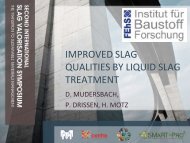International Slag Valorisation SymposiumLeuven6-7/4/2009 - Third ...
International Slag Valorisation SymposiumLeuven6-7/4/2009 - Third ...
International Slag Valorisation SymposiumLeuven6-7/4/2009 - Third ...
You also want an ePaper? Increase the reach of your titles
YUMPU automatically turns print PDFs into web optimized ePapers that Google loves.
leaching (mg/kg dry matt er)<br />
3.0<br />
2.5<br />
2.0<br />
1.5<br />
1.0<br />
0.5<br />
0.0<br />
0 25 50 75 100 125 150 175<br />
carbonation time (h)<br />
1 st <strong>International</strong> <strong>Slag</strong> <strong>Valorisation</strong> Symposium│Leuven│6-7/4/<strong>2009</strong><br />
Sb<br />
3.5<br />
3.0<br />
2.5<br />
2.0<br />
1.5<br />
1.0<br />
0.5<br />
0.0<br />
Cu<br />
0 25 50 75 100 125 150 175<br />
carbonation time (h)<br />
Figure 7: Leaching of antimony and copper as a function of carbonation time. The<br />
different data points at the same carbonation time indicate different processing<br />
conditions (temperature, CO 2 concentration, moisture content).<br />
In blended waste-cement monoliths the carbonate introduction and pH decrease become<br />
decoupled. 6,9) Because of the presence of Calcium-Silicate-Hydrate, a key component in<br />
hydrated cement with a high pH buffering capacity, progressive carbonation first<br />
introduces carbonate in the pore water without decreasing pH. As a result, calcium<br />
leaching decreases. Only at a more advanced stage of carbonation does the pH decrease<br />
and carbonates are converted into bicarbonates, the salts of which are highly soluble.<br />
Therefore, calcium leaching from almost completely carbonated with mildly acidic<br />
leachant is higher than leaching from partially carbonated samples. Metals for which the<br />
carbonate salt is more soluble than the hydroxide go through a different scheme. Lead,<br />
for example, is soluble at high pH as a lead hydroxide complex. The very limited pH<br />
decrease in the first stage of carbonation shifts the equilibrium to the precipitated lead<br />
hydroxide, thus lowering lead leaching. With more advanced carbonation and<br />
significantly decreasing pH, lead hydroxide is converted into the soluble lead<br />
bicarbonate salt, thereby increasing lead leaching again.<br />
Besides the effects on mineral speciation and pH, carbonation also affects porosity.<br />
Carbonation leads to an average decrease of porosity and a modified particle size<br />
distribution. 10) In blended waste-cement mortars it was found that the relative<br />
importance of small capillary pores ( 0.1 µm) increases. The effect of carbonation-induced porosity<br />
decrease on leaching was shown to be significant for pH independent components such<br />
as sodium and, to a lesser extent, potassium. However, for heavy metals the pH effect of<br />
carbonation will be much more important.<br />
With these studies, significant insights have been gained on the carbonation reaction<br />
mechanism in different materials such as lime mortars, lime-based hydraulic mortars,<br />
alkaline wastes and waste-cement blends. It has been confirmed that the role of water is<br />
one of the key parameters in the carbonation process in a porous system, which requires<br />
leaching (mg/kg dry mat ter)<br />
34







